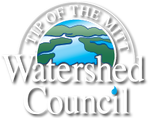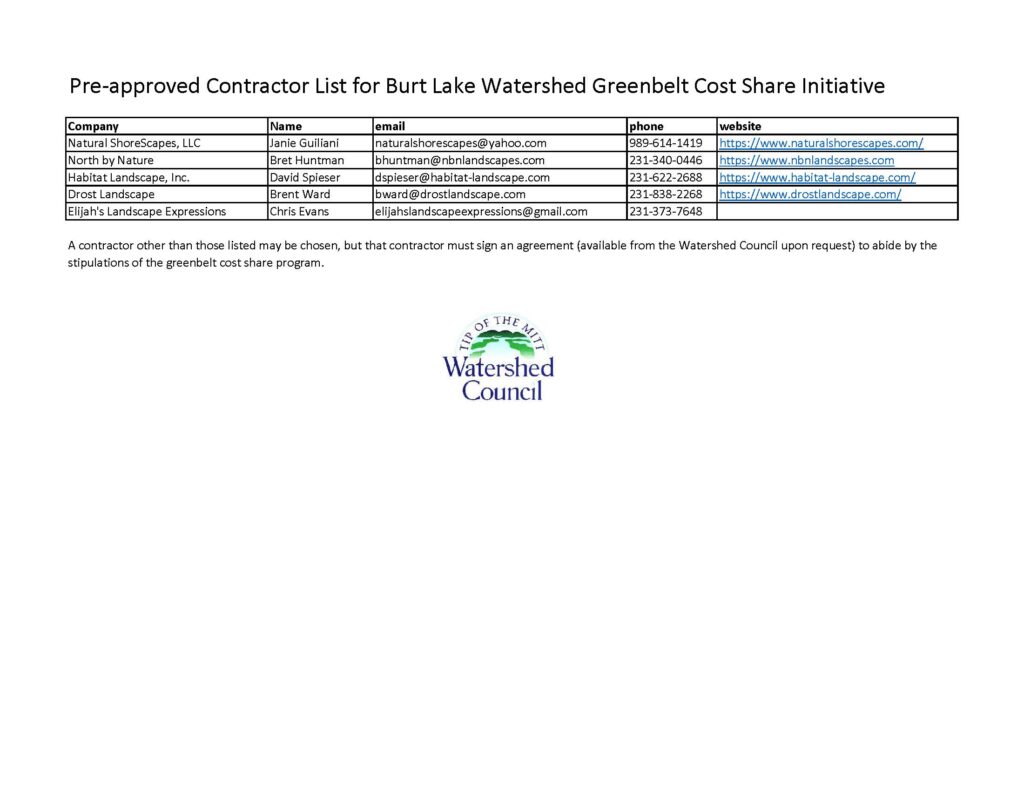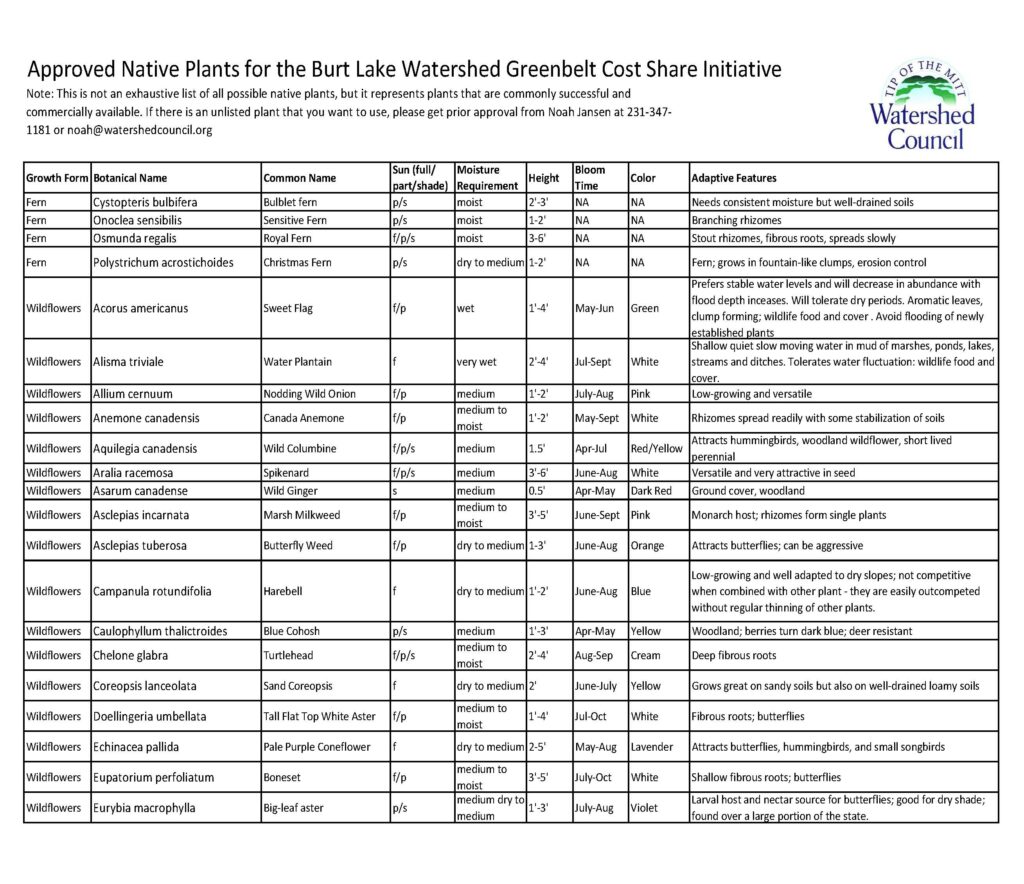Thank you for your interest in protecting Northern Michigan’s waters! In accordance with the Burt Lake Watershed Management Plan, Tip of the Mitt Watershed Council is pleased to announce our Burt Lake Watershed Greenbelt Cost Share Project. This project is a rare opportunity that will allow us to offer financial and technical support to property owners on Burt, Douglas, Crooked, and Pickerel Lakes for voluntary shoreline greenbelt improvement and restoration projects through a grant funded by the Michigan Department of the Environment, Great Lakes and Energy’s (EGLE) Nonpoint Source Program by the United States Environmental Protection Agency.
The steps for receiving greenbelt cost share funding are as follows:
- Review the terms below and complete the form. Applications will be evaluated by a rolling basis.
- Register (create an account) with Michigan Shoreland Stewards at mishorelandstewards.org and, while you are logged into your account, take the “Rate Your Shoreland” survey.
- Watershed Council staff will review applications for suitability using information stored in our database. Funding is limited, so applications will be ranked higher if:
- The property had a greenbelt score of less than 5 (poor to moderate) in the most recent shoreline survey done by the Watershed Council
- The property is in a greenbelt restoration priority area (as identified by the Watershed Council).
- There are greenbelts ranked “good” or “excellent” among your six nearest neighbors
- Note that if we receive more top-ranked applications than we can fund, cost share funds will be awarded on a first-come, first-served basis.
- The Watershed Council will contact you to set up an appointment for a site visit, which will be used to confirm suitable conditions, answer questions about the cost share program, and make recommendations for plant species that meet your goals.
- Submit a sketch of your proposed greenbelt planting to the Watershed Council for approval by EGLE (usually takes about a week). You may develop your planting design sketch on your own or with help from a contractor. Please use the species list provided during your site visit as a starting point. The drawing does not necessarily need to be to scale, but it should show a birds-eye view of your shoreline and show the approximate location of the proposed greenbelt and the dimensions of the area(s) to be planted. Show the approximate locations and sizes of the areas where different species will be planted. Include the approximate number of each species that will be planted (you can also provide the numbers of each species on a separate species list if you prefer). Also show the location of the lake and any other notable landmarks (dock, areas used for winter storage of the dock or boat hoist or storage of kayaks/recreational equipment in summer, hardscaped areas, etc.).
- Once your greenbelt drawing has been approved by EGLE, you are free to begin work on your greenbelt. Greenbelt projects must be completed by October 31, 2024 to qualify for cost share reimbursement. Remember to save copies of receipts or paid invoices so you can submit them for reimbursement.
- Once your greenbelt is completed, contact the Watershed Council for a follow-up site visit so that we can verify that the work has been done and take some pictures. Site visits must be completed by November 15, 2024, so contact us as soon as the work is finished.
- Log in to your MiSS account and take the “Rate your shoreland” survey again by November 15, 2024. This is one of the ways we demonstrate shoreline improvement.
- Submit copies of all receipts and paid invoices to the Watershed Council by November 15, 2024 so we can verify costs and determine the cost share amount.
- Get reimbursed for up to 50% of the cost of your greenbelt according to the terms below.
- Maintainence and care of your new greenbelt. You should plan to water regularly during the first year and during dry spells in subsequent years. Weeding and/or mulching will likely be necessary, at least for the first 2-3 years until the plants are well-established and have filled in the space.
- Sit back and enjoy your greenbelt!
Greenbelt Cost Share Terms:
Your completion of the application (below) does not guarantee cost share funding, but it does signify your interest in the Burt Lake Watershed Greenbelt Cost Share Project and your understanding of and agreement to the following terms:
- The Watershed Council will reimburse 50% of the cost for the property owner to install a greenbelt, up to a maximum of $2,000. For example, if the greenbelt installation cost was $3,000, we would reimburse the property owner $1,500. If the cost was $4,000 or more, we would reimburse the property owner $2,000.
- Only plants native to Michigan may be installed in the greenbelt, and native genotypes must be used (ornamental cultivars of native plants cannot be used). This list contains native plants that can be used in the project. If you wish to use other native species, please check with the staff at the Watershed Council.
- Completed greenbelts must extend at least 10 feet inland from the ordinary high water mark and at least 50 feet along the shoreline. For small lots, where a length of 50 feet is not practical, greenbelts that extend along at least 75% of the shoreline and at least 10 feet inland may be allowed.
- The property owner should arrange to design and implement the project themselves or work with a contractor skilled and experienced in the practice of natural shorelines. A contractor other than those listed may be chosen, but that contractor must sign an agreement (available from the Watershed Council upon request) to abide by the stipulations of the greenbelt cost share program.
- The property owner will allow Tip of the Mitt Watershed Council and our representatives to access the site before, during, and after installation. The Watershed Council will be allowed to photograph and feature the greenbelt project in our newsletter, website, presentations, and social media. We will omit your name and address upon request.
- The property owner will maintain (water regularly during the initial installation period, weed, etc.) the greenbelt as necessary in order to yield the best results in the future.
- The property owner will complete the steps outlined above by the deadlines listed.
Resources
Please click on the photos to view the documents.



